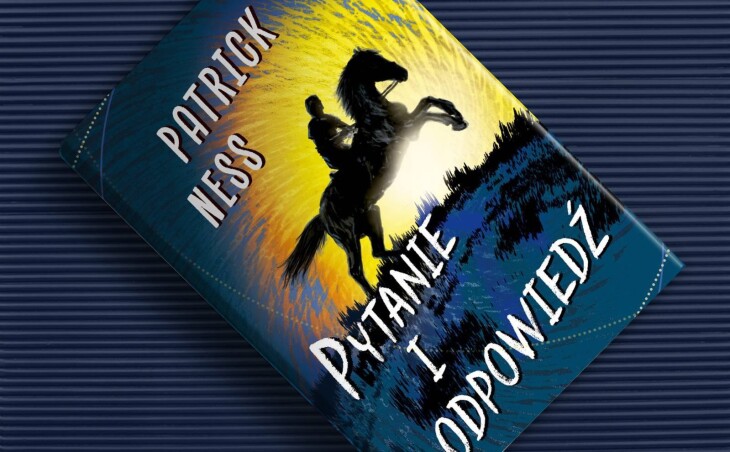After the blockbuster On the Knife’s Edge, which is the introduction to the Moving Chaos trilogy , it would be hard to expect that its sequel could be as good. Patrick Ness proves beyond a doubt that he is one of the most interesting authors dealing with young adult literature .
I am Todd Hewitt, I am Todd Hewitt, I am …
Question and answerbasically starts shortly after the dramatic finale of the first part. Fleeing from Mayor Prentiss’s army, Todd and Viola make their way to Haven, only to learn that the city has surrendered without a fight and is ruled by a deadly enemy. From that moment on, successive events are a downward slope for the two heroes – not only are they separated, but also the thread of trust developed in the sweat of their brow is inextricably broken. Contrary to all expectations, New Prentisstown under the Mayor’s rule seems to flourish, and the tormentor himself proclaims a message of new order and prosperity to all. But is it really possible to trust him? To learn the truth, Todd and Viola will not only have to adapt to the new reality, but also fight for their own identity and humanity.
Humming louder than ever
Turning the situation upside down in the last act of the first part could be interpreted as an effective, if somewhat cheap cliffhanger , designed to encourage us to read the sequel . Doubts about the use of such a solution while reading Questions and Answers evaporate as quickly as the protagonists’ view of the new reality. It quickly turns out that Patrick Ness undoubtedly had a forward idea for the rest of the story.
According to the unwritten rules of creating a continuation, there should be more of everything the second time around. And that’s exactly the case with the Question and Answer . And so, for example, Noise – thoughts of men that can be heard by other living creatures – in the prototype being an intriguing curiosity, here becomes a weapon and a tool of indoctrination of the masses. We also have a lot more elements in the sequel that distinguish the pretentious young adultfrom novels aspiring to the title of works proclaiming universal truths. Thus, the book will contain analogies to the totalitarian system and political propaganda, and there will also be questions about the limits of morality in the eternal war between good and evil. Does an enlightened end always justify the means? Is conformism when faced with loss of life always fundamentally wrong? Such questions will have to be answered not only by the heroes, but also by ourselves.
More importantly, however, the fullness of Ness’s ability to create situations that lead us to such considerations reveals itself in constantly keeping the recipient in a state of uncertainty. For one questionable action of one of the parties to the conflict, we get two more from the other side of the barricade, and in fact, throughout the span of Questions and Answers , we will not be able to be sure whose right we should consider the right one.
Heroes first
Nie miałyby tego typu rozważania aż takiej mocy uderzeniowej, gdyby nie fakt, że u Patricka Nessa wciąż na pierwszym planie znajdują się znakomicie wykreowane postaci. Zarówno ci, których chcielibyśmy uznawać za „dobrych”, jak i antagoniści to jednostki pełne sprzeczności, wewnętrznych konfliktów i narastających wątpliwości, a to, co uznawaliśmy w ich ocenie za pewnik po przeczytaniu części pierwszej, zostanie w Pytaniu i odpowiedzi poddane wielokrotnej weryfikacji. Dzięki takiemu podejściu wrażenie że mamy do czynienia z osobami z krwi i kości jest wręcz dojmujące, a znajdującym się w centralnym punkcie wydarzeń Toddowi i Violi ciężko nie kibicować, gdy w końcu wydarzenia po raz kolejny przybiorą dramatyczny obrót. A że Patrick Ness potrafi w ich przedstawianiu być równie bezkompromisowy, co w poprzedniej powieści (przypomnijcie sobie w tym miejscu scenę z Manczim), momentów. w których emocje sięgają zenitu, znajduje się tu aż nazbyt wiele.
W oczekiwaniu na wielki finał
Pytanie i odpowiedź to zatem wręcz modelowy przykład tego, jak powinno pisać się środkowe części trylogii. Nie tylko mamy tu do czynienia z jeszcze głębszym zarysowaniem przedstawionej w pierwowzorze tematyki, ale też kolejne punkty, nad którymi będziemy zmuszeni zastanowić się przed częścią ostatnią. Biorąc pod uwagę co do tej pory w Ruchomym chaosie Ness nam zaprezentował, o jej jakość jestem bardziej niż spokojny.
Nasza ocena: 8.7/10
Patrick Ness udowadnia, że jego Ruchomy chaos to obecnie prawdopodobnie najlepsze young adult na rynku.BOHATEROWIE: 9/10
EDITION AND PROOFREADING: 8/10
FABUŁA: 9/10
STYLE: 9/10

